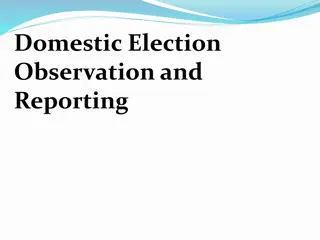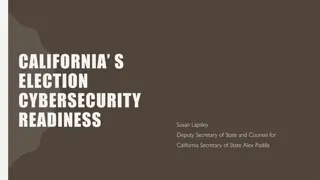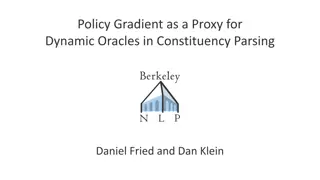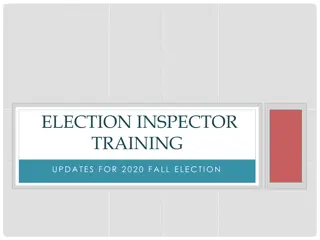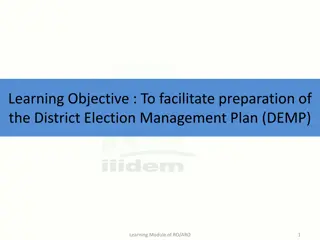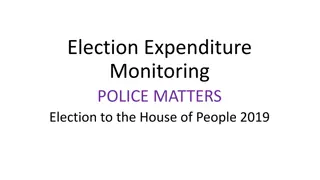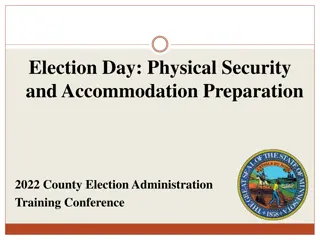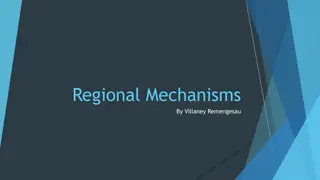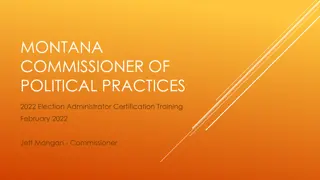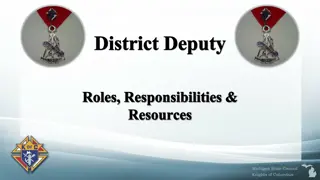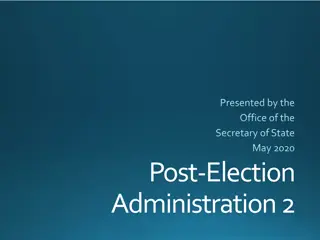Comprehensive Guide to District and Constituency Election Planning
This presentation delves into the intricate details of District and Constituency Election Management Plans (DEMP), focusing on various aspects such as district profiles, EVM management, security deployment, communication strategies, and training. It emphasizes the importance of interaction with political parties, media management, and specialized monitoring cells for successful election execution. The session also covers the significance of preparing a District Election Plan, highlighting its form, flow, and utility in effective election management.
Download Presentation

Please find below an Image/Link to download the presentation.
The content on the website is provided AS IS for your information and personal use only. It may not be sold, licensed, or shared on other websites without obtaining consent from the author. Download presentation by click this link. If you encounter any issues during the download, it is possible that the publisher has removed the file from their server.
E N D
Presentation Transcript
Theme 12 - DEMP & Constituency Plan Guidance Plan: 1. This PPT explains the concept, principles, components and guidelines for District and Constituency level election planning for conducting free and fair elections. 2. In the opening part, while listing the statutory duties of DEO, the elements for DEMP are introduced. 3. PPT goes on to explain how the district profile w.r.t social and geographical characteristics, past record during elections, identification of sensitive and critical PS and proper Vulnerability Mapping can help in good planning. 4. PPT lists the major focus areas such as EVM management, communication plan, effective deployment of security forces, expenditure monitoring, complaints management and intensive training of all personnel. 5. The latter part of the PPT explains how interaction with political parties, media management, using specialised cells for specific areas of monitoring and SVEEP initiatives become effective tools in executing smooth elections. 6. The PPT ends with the various components of Booth/BLO level planning, PS management and the critical mistakes on poll-day that can spoil the good work. 1
ECI Instructions and Election Planner ECI Instructions and Election Planner Election planner has been prepared and circulated by ECI, by its instruction- No 464/INST/2016- EPS dated 6th January 2017. It provides general operational framework to election managers. It is only indicative in nature and does not intend to replace, alter or supplant the extant election related statute, rules or existing guidelines, instructions and procedures mandated by the Commission. A weekly and daily monitoring mechanism is to be put in place to monitor the implementation of each of the activity. NB 1: given the diversity and specificity of States, Districts and Assembly Constituencies, DEO/RO must customize the planning process to deal with those specific circumstances. These could include specific law and order inputs and other critical aspects NB 2: ECI has recently launched a Planning Portal which should be fully utilized and the relevant information required to be fed in the Portal must be ensured within the given timelines
Objective: This session will provide an understanding regarding preparation of a District Election Plan, its form and flow, its utility in effective election management. CONTENTS: 1. Definition of DEMP 2. ECI instructions on DEMP 3. Preparation of DEMP- Duties of DEO 4. Components of DEMP 5. ACEMP Definition and Preparation 7. Conclusion
Definition of DEMP: DEMP is the basic exercise which enables the DEO to plan election management from Micro planning to Macro planning. Understanding DEMP: Q. Is DEMP a strategic plan or an operation plan? A: DEMP is an operational plan with a number of sub-plans in it, essentially for conducting an election.
Levels of election planning Levels of election planning 1. State Plan. 2. District Plan. 3. Assembly Constituency Plan ERO / AERO Centric. RO/ARO Centric 4. Booth Level plan BLO centric. PRO Centric
DEMP DEMP - - Process of Preparation Process of Preparation SO collects field data ARO compiles the data ARO submits preliminary report RO checks and makes modifications as required to RO RO submits to DEO DEO finalizes the plan DEMP sent to CEO who suggests changes, if any
Statutory duties of DEO Electoral Rolls: S 13AA of RPA 1950, prescribes that subject to the superintendence, direction and control of the CEO, the DEO shall coordinate and supervise all work in the district or in the area within his jurisdiction in connection with the preparation and revision of Electoral Rolls. Conduct of Elections: As per S20A of RPA 1951, the DEO shall coordinate and supervise all work in the district or in the area within his jurisdiction in connection with the conduct of Elections. Contd
Statutory duties of DEO contd. Polling stations: As per S 25 RPA 1951, the DEO shall with previous approval of the ECI make provisions for sufficient number of polling stations and also publish the same Poll personnel: The DEO shall appoint the Presiding and polling officers for each of the polling station to perform the poll duty (S 26 RPA 1951) Expenditure Monitoring: As per S 78 RPA 1951, every contesting candidate shall within thirty days of the result lodge his election expenditure account with the DEO and the DEO will report to the Commission under R 89 COER, 1961 Contd
Statutory duties of DEO contd. The DEO is the custodian of all EVMs, election related papers, ballot boxes, etc. as per R 92 COER 1961. The District Election Officer is overall in-charge of all activities relating to the preparation and revision of electoral rolls, setting up of polling stations, appointment of poll personnel, EVM storage and FLC. Counting center arrangements, Expenditure monitoring, Communication Plan, grievances redressal and also custodian of all election materials. NB 1: Booth Level Election Management Plan (BEMP) is an independent imperative in planning as it provides a bottom-up approach and chisels out the BLO and PrO-centric perspective.
Components of District Election Management Plan Components of District Election Management Plan Contd
Components of District Election Management Plan Components of District Election Management Plan contd. contd.
Components of District Plan Components of District Plan 1 2 3 4 5 6 7 8 9 10 District Profile Electoral Roll Management Polling Stations and Infrastructure Vulnerability and Criticality Security plan and Force Deployment Communication Plan EVM Management Poll personnel management and Welfare Model Code and enforcement Expenditure Monitoring Contd
Components of District Plan Components of District Plan contd. contd. 11 Transport and Movement Plan - Personnel and Machinery 12 Complaint Redressal 13 SVEEP Systematic Voter Education and Electoral Participation 14 Training and Awareness to all stake holders 15 IT interventions for better election management 16 Counting Plan 17 Material Management 18 Voter Assistance and Facilitation 19 PWD Facilities 20 Interface with Political Parties NB: BEMP Booth Level Election Management Plan to be integrated with DEMP
DEMP creation of District profile Documents/particulars/records required for creating district profile: District political map for planning. Key Statistics- Villages, Gram Panchayats, police stations, urban local bodies, census, elector details, death registrations, roads, connectivity, Administrative set up, Terrain, polling stations, Infrastructure and manpower availability. General Law and Order. Past Election snippets- voter turnout. Past electoral offences. Sensitivity etc.
DEMP Electoral Details ER statistics analysis identifying gaps inaccessible hamlets - strategy for improvement: District wise, Constituency wise, booth wise electoral statistics. Analysis of the Health of rolls, identifying gaps and making strategies for improvement. Roll revision and supervisory mechanism BLOs/ Designated Officers / multi level checking / Audit of roll revision processes. Vulnerable and inaccessible hamlets and enrollment challenges. Monitoring disposal of online applications. Printing of rolls and its publication.
DEMP - Major Requisite Information Human Resources and Logistic Plan Polling Stations Movement Plan Polling stations , buildings, infrastructure and AMF facilities. Constituency wise no. of polling stations and communication plan Polling stations categorized by no. of voters Polling Stations accessible by vehicles Polling Stations without telephone lines. Publication of PS list after approval of ECI Assess manpower requirement at various levels Compilation of particulars of officials/officers working at govt. offices/ PSUs No. of eligible personnel and no. of personnel required. Appointment of poll personnel for the poll Movement plan for polling parties with route charts, sector wise Sketch Map of Constituency showing sector routes Assessment of vehicle requirements Contd..
DEMP - Major Requisite Information contd. Sketch Map of Constituency showing Sector routes Polling Station-4 Various Routes to reach Polling stations Polling Station-1 Polling Station-5 Alternate Routes to reach Polling stations Polling Station-3 Shortest Routes to reach Polling stations Polling Station-2 Polling Station-6 Road Condition, River, Nala, Bridge Distance and approximate time to reach
DEMP DEMP - - vulnerability and criticality vulnerability and criticality Critical and vulnerable PS identification force deployment plan force multipliers: The DEO with the inputs from the sector officers and the police has to prepare vulnerability mapping of polling stations. The past electoral disturbances, offences, intimidators, persons who may cause vulnerability are all to be taken into account. Criticality analysis of polling stations have to be made based on the voter turnout and other historical information. DEO has to make a deployment plan based on the analysis and also plan for force multipliers like video cameras, web cast, micro-observers etc. to cover all hypersensitive locations.
DEMP - EVM Management Assessment of Requirement Polling station, auxiliary booths, reserve Request for additional to meet the shortfall. Obtain EVM-VVPAT consumables- Power packs , paper rolls and batteries from CEO Office. FLC, Randomisation and storage of machines Organise EVM-VVPAT awareness programmes at the District, Assembly and booth level for all stake holders.
DEMP EVM & VVPAT Awareness SVEEP Plan Three Level Planning: 2. District Level Planning: Sl No Description Start Date End Date Status 1 Training and Capacity Building for all the officers. 2 Use of Social Media- Disseminate awareness messages though Facebook, Twitter, Instagram at CEO Level 3 Short films on EVMs-VVPATs to be run on Cable TV. 4 Distribution of Pamphlets through News papers 5 Slides of EVM-VVPAT to be played in theatres and cinema halls ahead of elections.
DEMP DEMP - - Human Resources, Poll Personnel Management and Welfare Human Resources, Poll Personnel Management and Welfare Requirement of officials filling up positions Filling up of AERO/ ERO/ RO and Election branch officials Filling up all other election related posts at State, District and Assembly level. Preparation of the data base of poll personnel and collecting and updating their EPIC details. Estimating the GAP between the required and shortfall make strategies for filling up the GAP. Implementing Welfare measures. Provision for Polling Staff Welfare Name, Designation and contact details of nodal officer in charge of ensuring polling personnel welfare Clear communication of training schedule, dispatching schedule Basic amenities at training and dispatching venue Facilities at PS to be physically verified and ensured - Adequate facilities for food, refreshments and medical requirements to be made Immediate relieving from duty after handover of EVMs and polling materials Advance measures to ensure transport facilities for staff Special facilities/measures for physically challenged, female polling personnel, death of personnel on duty
DEMP - District Level Team for Model Code of Conduct Sl. No. Particulars Designation 1 District Head District Election Officer and District Election Officer 2 Police Superintendent of Police of the Concerned dist 3 4 5 Income Tax Commercial Excise Income Tax office of the District Commercial Tax Officer of the District Deputy Commissioner of Excise of the district. 6 District MCC Nodal Officer Nodal Officer Role and responsibilities of the District MCC monitoring cell: To constitute Flying Squad, SST and such other enforcement teams required assembly constituency wise for enforcement of MCC by selecting competent officers and staff. To train officers deployed for Model Code of Conduct teams, political parties and press on Model Code of Conduct. To provide required men and material to these teams as per ECI guidelines for effective functioning. To issue time to time instructions to all Model Code of Conduct teams for effective enforcement of Model Code of Conduct. To circulate latest instructions on Model Code of Conduct among all Model Code of Conduct teams. To monitor and guide all activities of Model Code of Conduct teams for effective functioning. To obtain and consolidate Model Code of Conduct reports and forward that same to state Model Code of Conduct Cell. To attend such other responsibilities entrusted by state Model Code of Conduct Cell.
District Election Expenditure Monitoring Cell SL.No. Official Designation EEM Designation 1. 2. 3. 4. District election officer Additional DEO Nodal officer media monitoring cell District nodal officer for election expenditure monitoring Chairman Member Member Member secretary Role and responsibilities of the District election expenditure monitoring cell: To constitute VST, VVT, AT and Assistant expenditure observer assembly constituency vise by selecting competent officers and staff. To train officers deployed in the election expenditure monitoring teams, political parties and press on election expenditure monitoring To provide required men and material to these teams as per ECI guidelines for effective functioning. To issue time to time instructions to all expenditure monitoring teams for effective implementation of election expenditure monitoring guidelines. To circulate latest instructions on election expenditure monitoring among all expenditure monitoring teams. To monitor and guide all activities of election expenditure monitoring teams for effective functioning. To obtain and consolidate election expenditure monitoring reports and forward that same to state expenditure monitoring cell. To attend such other responsibilities entrusted by state expenditure monitoring cell.
DEMP DEMP - - Security Plan and Force Deployment Security Plan and Force Deployment Assessing police personnel requirement movement plan: Assessment of Requirement of police personnel (various ranks) For sector movement and to man polling stations Prepare return journey for polled EVMs/Polling material, their storage and security plan till counting
DEMP - Communication Plan List of landline and cellular connections available near each PS along with particulars of contact person List of polling personnel/ SO with cellular numbers Plan mode of communication such as VHF/HF to ensure connectivity in mobile shadow regions
District Complaint Monitoring Cell Complaint Monitoring Cell - toll free telephone number wide publicity - sufficient staff round the clock shift: DEOs are instructed to establish Complaint Monitoring Cell with a 24 x 7 Call Centre in the Control Room at the district-level from date of announcement of the elections. The call centre should be equipped with a toll free telephone number with 3 or 4 hunting lines which will be widely publicized to enable the public to inform the election monitoring machinery regarding corrupt practices, violation of MCC, other electoral offences etc. A senior competent officer should be in charge of the complaint cell and he will be responsible for receiving and recording the complaints and passing them on to the officer concerned of the Flying Squads which are GPS monitored for prompt action. The call centre will be provided with sufficient staff to manage the telephone line round the clock in well defined and organized shifts.
SVEEP as a component in DEMP Systematic Voters Education And Electoral Participation Systematic Voters Education And Electoral Participation It handles work related to all aspects of Voters Awareness & Education aimed towards improving Electoral Participation and building up a culture of participative democracy among citizens
Training Plan at DistrictLevel Duration of training No. Of Participants Level Training by Participants District Nodal Officer - EM /SLMT Expenditure Monitoring Teams District 1 day District SLMT Sector Officers 1 day Police officers in the rank of Addl. SP/Dy. SP/ Circle Inspector / Inspectors District Nodal Officer- Police /SLMT District 1 day District DEO/RO Executive Magistrates 3 hrs District Nodal Officer- Income Tax / SLMT District Income Tax Officers 1 day District Nodal Officer- Excise/SLMT District Excise Dept. Officers 1 day District SLMT Political Parties 3 hrs District SLMT Media 2 hrs
IT preparations IT infrastructure for RO/ARO/ERO/AERO training in IT applications/portal modules DEO website Nodal officer as contact point: DEO should ensure that every AERO/ ERO and the Returning Officer offices are well equipped with enough number of computers, printers, internet facility etc. and data entry operators. District Information Officer, NIC should be involved in better management. Organize training to all personnel on ECI IT applications and CEO portal modules. Prepare DEO web sites for dissemination of election related information. Appoint a Nodal Officer as a one point contact.
Counting plan Counting plan Identification Centre/Counting Halls. Strong Room s (Storage places for EVM s)--Pre Poll and Post Poll Strong rooms. Finalisation of all places of mustering, training Demustering, centres. IT infrastructure at counting center. Media room at the Counting center. Counting staff, training, welfare and deployment. Sealing , packing post counting materials and machines. of Counting Key Points: Key Points: Identify places for storage of EVMs & Polling materials Submit Proposal to CEO for approval from ECI in advance Assess Counting Staff availability Detail other logistics, media and security arrangements
Material management Assessment of material requirement purchase at CEO level/DEO level procurement one month in advance: Assess the hologram requirement well in advance and place request for procurement. EVM-VVPAT consumables, batteries, power packs, paper seals etc will be procured by CEO Office. Statutory forms, covers, etc. will be supplied by CEO Office. Appoint a Nodal person to check the requirement and shortfall and to liaison with CEO Office List the materials to be procured at District Level and complete procurements at least one month in advance Refer to the relevant chapters of RO Hand Book and ECI instructions
Voter assistance and PwD Voter assistance and PwD Helpdesk at all levels control room 24X7 mapping of PwD electors and assistance - voter assistance booth on poll-day home voting for senior citizens and PwD advance voting: DEO should ensure that the help desk are functioning at DEO / RO/ ARO/ ERO/ AERO offices. Control room to record complaints and grievances are functioning 24 X 7. Identify and map PWD and provide all assistance for their enrollment and voting. Explore online booking of requests. Prepare DEO web site for voter name search. Keep a copy of alphabetical list at RO Help desk. Voter assistance booths should be operational on poll day. NB: New Instructions DEO and RO to plan for executing Home Voting facility for PwD/80+ and advance voting for essential service category officials
Interface with Political Parties Regular meeting to brief them about the Important ECI instructions and schedules. Briefing them about the provisions of the Model Code and Expenditure monitoring. EVM- VVPAT Awareness among political Leaders. Involving all Political Parties in electoral roll revision . Grievances Redressal meetings. Meetings for seeking co-operation, feedback and suggestions.
Role and Responsibilities ERO Role and Responsibilities ERO Electoral Roll cleansing of roll - error free voter awareness/assistance redressal of grievances: Electoral Roll, Voter slip, EPIC etc.: The ERO/ AERO are statutorily responsible for preparation and revision of Electoral Rolls. EROs should seriously take up the activity of cleansing of rolls with the guidance of the CEO and DEO. Rolls should be all inclusive and error free. SVEEP, house to house visit, Voter awareness, Voter facilitation, assistance, redressal of roll related grievances etc.
Role and Responsibilities of RO Role and Responsibilities of RO Conduct of Elections: Nomination, scrutiny, ballot paper, training, model code, expenditure monitoring, polling stations, poll personnel management, postal ballot management, EVM preparations and demonstrations, welfare of personnel, poll day monitoring and reporting, counting arrangements etc. ROs are statutorily responsible for conduct of elections in the fee and fair manner in their respective constituencies
ERO Centric Plan ERO Centric Plan Plan of action for preparing accurate and error free ER, a prerequisite for the conduct of free and fair elections. Pre revision activities: Analysis of health of ER, identifying gaps and errors and taking corrective action. Identifying absent, shifted, dead (ASD) voters and removing them with due procedure. Rationalization and movement of voters with utmost care and keep all stakeholders and voters well informed at very stage. Summary revision: Identifying eligible for enrollment- house to house visit by BLOs, Monitoring, supervising BLO work. Contd
ERO Centric Plan ERO Centric Plan contd. contd. Timely and prompt action in disposing of all pending applications- online and offline. Effective grievance redressal mechanism. Actively Involving political parties, BLAs, RWAs, media in the process of roll revision. SVEEP activities at booth level, Constituency level. Booth Awareness groups, awareness among students on enrollment, Activating Campus ambassadors. Wide publicity to roll revision schedules, maximum out reach through all means. Timely issue of EPIC cards, Voter Information Slips Proper account of Holograms and placing timely request for additional supply.
Assembly segment wise Election Plan Assembly segment wise Election Plan (ECI No. 464/INST/2008 (ECI No. 464/INST/2008- -EPS dt. 24.10.08) EPS dt. 24.10.08) Compiling details of PS categorization Sector formation: Details of PSs - Total number - categorization of PSs urban/ rural/ polling locations. Sectors to be formed - one sector (cluster of PSs) should fall on one common road.
RO centric plan RO centric plan Plan of action for RO to conduct free, fair and smooth election training of staff - updating on statutory provisions and latest ECI instructions: Get to know all Legal and Statutory provisions. Familiarize with latest ECI instructions on the conduct of elections. Polling station inspections and ensuring AMF. Appoint Nodal Officers to assist you in various activities Training Poll personnel/SO and all other election officials on all legal and procedural aspects of their area of responsibilities. Nominations, scrutiny, symbol allotment Update your self with latest ECI instructions and circulars. Familiarize with the general Law and Order situation, sensitivity of the area, and prepare yourself to tackle unforeseen.
Sector Management Plan Sector Management Plan Sector formation synchronizing sector with police mobile team: Sectors to be formed in advance so that immediately after the announcement of elections, the SOs could be appointed. Area of the Sector Officers/Zonal Magistrates and police mobile team should be same.
Premises for various election activities/personnel Premises for various election activities/personnel Selection of buildings/premises for various activities a)For training classes to polling personnel etc. b)For checking and preparation of EVMs and their storage. c)For storage of EVMs to be used in training d)For storage of EVMs AC wise after first randomization. e)For Dispersal centers f)For safe custody of polled EVMs and counting of votes. g)For boarding and lodging of central forces/ outside police forces h)For boarding and lodging of polling personnel, if required. Contd
Control Room/MCC Teams/IT activities Control Room/MCC Teams/IT activities Control Room - To be well equipped MCC Teams - complaint monitoring system. (i) Nodal Officer (ii) Formation of MCC team AC wise. (iii) Register to be maintained. ATR and daily monitoring IT related activities - a technical team comprising at least one programmer and two data entry operators must be available full time at district level Contd
Formation of Formation of various various cells cells Deputing staff and formation of various cells for general arrangements - Duties to be assigned for following events: Transportation arrangements Polling personnel Complaint monitoring Facilitation center (Helpline & Control Printing of Postal Ballots and Room) EVM ballots Polling stations Election Expenses Media center/cell Issue of Postal Ballots/ EDC Electoral Roll Procurement and distribution EVMs of election materials Contd
Formation of Formation of various various cells cells contd. contd. Deputing staff and formation of various cells for general arrangements - Duties to be assigned for following events: Route Chart preparation - sector movement plan Vulnerability Mapping Liaisoning with Observers Counting center Counting Staff Critical Polling stations Issue of Identity Card Law and Order Training Model Code of conduct and Micro Observer videography Polling personnel welfare Police Personnel Computerization/ Randomization Zonal officer/Sector officers Communication plan, Statistical Data Cell Arrangements at Distribution Centre, reception Distribution of Voter Information Slip Centre
Meeting with political parties Meeting with political parties Meeting with political parties/Standing Committee - Meeting as often as may be convenient after declaration of election Appeal to cooperate in the observance of model code of conduct for free and fair elections and to maintain law and order Minutes be drawn - Not to be used as mere formality.
Media Cell Activities of Media Cell: Nodal Officer to coordinate all activities Holding meetings with media Giving information on nominations, affidavits, etc and other events - Sharing other information Coverage on poll day Coverage on counting day Authority letters.
Facilities for Observers Facilities for Observers I dt. 9- -1 1- -2007 and No. 464/INST/ 2007/PLN 2007 and No. 464/INST/ 2007/PLN- -I dt. 12.10.2007] 12.10.2007] [ECI's No. 464/OBS/2007/PLN [ECI's No. 464/OBS/2007/PLN- -I dt. 9 I dt. Facilities and logistics support for Observer personnel to assist: Boarding, lodging, transport and security to be arranged by DEO. Stationary, wireless communication, guide and secretarial assistance be provided. Contingency expenditure, if any, incurred by observer will also be reimbursed Fax machine of district administration be used by Observer on a priority basis and confidentiality be maintained One telephone line is sufficient for use of more than one Observer being housed in same premises. Contd
Facilities for Observers contd. STD telephone with fax facility at counting centers. Give constituency maps, list of PSs, table of contents of electoral rolls, telephone numbers, book-let containing plan of election and counting of votes. Proper transport from nearest railway station/airport to constituency. No Guard of Honor - No escort car/pilot or advance pilot. Place of stay, phone number and dates of visits of Observer should be publicized. Food arrangements by district administration Every Observer will be provided a video camera and a videographer from the day he reaches the constituency. If suitable Government Guest Houses not available provide alternative accommodation in consultation with CEO. TA / DA - be drawn from parental ministry / department / office
Restrictions on the Printing of pamphlets, posters etc., Restrictions on the Printing of pamphlets, posters etc., Ensure whether printers and publishers are complying with the provisions of S 127A RPA 1951. All the printing presses shall be informed within 3 days of announcement of election in writing by the District Magistrate to furnish information and printed material as required S 127A RPA 1951 - Attention towards provisions of S 77(1) and 127A of RPA and S 171 H of IPC and ECI's directions may also be drawn. Contd
Restrictions on the Printing of pamphlets, posters etc., - contd Four copies of such printed material along with declaration of the publisher shall be furnished to DM/DEO by the printer within 3 days of printing. List of all the election pamphlets, posters etc shall be exhibited on the notice board of DM/DEO. Surrogate advertisements in print media for/against a political party/candidate - Expenditure involved in such advertisement has to be added to account of election expenses u/s 77(1), hence required to be maintained - S 171H IPC prohibits expenditure without authority from the candidate. Strict action on violation of the provisions of S 77(1) and 127A RPA 1951, 171H of IPC and ECI s directions. A press note should be issued drawing attention towards provisions of S 77(1) and 127A RPA 1951 and S 171H of IPC. A report be sent to CEO after completion of election.





